

Customer Experience v User Experience. In the process of writing the book (, yes, it’s coming, I promise!)
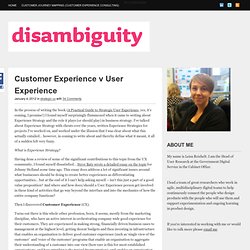
I found myself surprisingly flummoxed when it came to writing about Experience Strategy and the role it plays (or should play) in business strategy. I’ve talked about Experience Strategy with clients over the years, written Experience Strategies for projects I’ve worked on, and worked under the illusion that I was clear about what this actually entailed… however, in coming to write about and thereby define what it meant, it all of a sudden felt very fuzzy. What is Experience Strategy? Having done a review of some of the significant contributions to this topic from the UX community, I found myself dissatisfied… for Johnny Holland some time ago. This essay does address a lot of significant issues around what businesses should be doing to create better experiences as differentiating opportunities… but at the end of it I can’t help asking myself – isn’t this just a part of a good value proposition?
This worries me. Do the hard work to make it simple. This is apparently a slide from a Google engineer highlighting their focus on the user.

I don’t know who the quote is from but it was tweeted by Paul Frampton the other day. How Mature is Your Organization when it Comes to UX? Every organization has its own goals, processes, techniques, and teams—each with special characteristics.
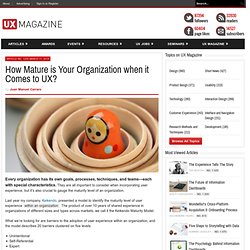
They are all important to consider when incorporating user experience, but it’s also crucial to gauge the maturity level of an organization. Last year my company, Keikendo, presented a model to identify the maturity level of user experience within an organization. The product of over 10 years of shared experience in organizations of different sizes and types across markets, we call it the Keikendo Maturity Model. What we’re looking for are barriers to the adoption of user experience within an organization, and the model describes 20 barriers clustered on five levels: UnintentionalSelf-ReferentialExpertCentralizedDistributed It is possible that the 20 barriers do not cover all situations in all organizations, but they do address the most common barriers that occur at each level. 1. 2.
At this level, organizations design products as if their users think and act just like they do. 3. 4. Treatise on User Experience Design: Part 1. User Experience, Incorporated. By Robert Fabricant - January 7, 2013 In business today, “user experience” (or UX) has come to represent all of the qualities of a product or service that make it relevant or meaningful to an end-user -- everything from its look and feel design to how it responds when users interact with it, to the way it fits into people’s daily lives.
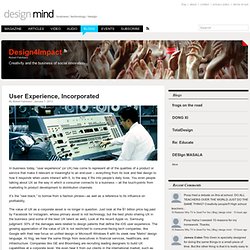
You even people talking about UX as the way in which a consumer connects to a business -- all the touch-points from marketing to product development to distribution channels. It’s the “new black,” to borrow from a fashion phrase—as well as a reference to its influence on profitability. The value of UX as a corporate asset is no longer in question. Just look at the $1 billion price tag paid by Facebook for Instagram, whose primary asset is not technology, but the best photo sharing UX in the business (and some of the best UX talent as well).
Scalable Strategies for Managing UX 1. 2. 3. 4. 5. Thirteen Tenets Of User Experience. Advertisement In my career as a user experience professional, part of my purpose has always been to help push our profession forward.
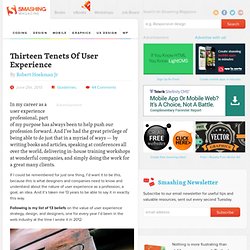
And I’ve had the great privilege of being able to do just that in a myriad of ways — by writing books and articles, speaking at conferences all over the world, delivering in-house training workshops at wonderful companies, and simply doing the work for a great many clients. Who Are We and What are We Doing? For the past several months, I’ve been actively investigating the UX jobs market as part of an effort we announced back in January to explore the employment issues endemic to our field. Through in-person research in several major cities and by working with Didus, a UX-focused recruiting and career development agency , I’ve seen the opportunities and problems up close.
In part, this research has exposed the immaturity of the UX field. For all the growth, interest, and importance surrounding user-centered ideas and practices, our professional milieu is still a disorderly jungle. The fundamental issue is that we’re growing outward faster than we’re firming things up inward, and new concepts enter the conversation before old ones have been fully established, methodized, and universalized. This problem is in evidence wherever you look in the field. For example, what about persuasive design ?
So you wanna be a user experience designer — Step 1: Resources. Want to pursue a career in UX, but don’t know where to start?
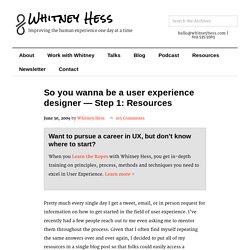
When you Learn the Ropes with Whitney Hess, you get in-depth training on principles, process, methods and techniques you need to excel in User Experience. Learn more > Pretty much every single day I get a tweet, email, or in person request for information on how to get started in the field of user experience. I’ve recently had a few people reach out to me even asking me to mentor them throughout the process.
Given that I often find myself repeating the same answers over and over again, I decided to put all of my resources in a single blog post so that folks could easily access a consolidated version of my advice. What is a UX designer / IA? There's a certain amount of terminology used on this site that assumes a reasonable level of previous exposure to the world of UX design and Information Architecture (IA).

One of the key considerations in my role as a user experience designer is to make sure that the site or application I'm designing makes sense to the target user groups, and phraseology and terminology form a large part of this. With this in mind, the remainder of this page is my take on some of the common terminology associated with the realm of UX design in the hope that it may help those getting acquainted with this field. If you are interested in finding out more about this area of website and application design and production, please feel free contact me and I'll do my best to help. Alternatively I am available for UX consultations online via Skype which can be booked via the contact me page. The Difference Between Usability and User Experience.
As long as there’s been an Internet, the discussion between user experience and usability has been explored.
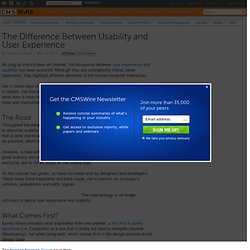
Although they are conceptually linked, taken separately, they highlight different elements of the human-computer interaction. Yet in these days of advanced user interfaces, from mobile devices to e-readers to tablets, has the line between user experience and usability blurred? And if so, what does it mean for web standards and design? We examine their distinctions, roles and implications in an effort to answer these questions.